The Amateur Mycologist #24 - Grifola frondosa - The Hen Of The Woods/The Maitake.
These posts are not for foraging. They are intended for entertainment and intellectual satisfaction only. These posts are not a field guide nor comprehensive in any way - their accuracy is not assured in any way. Do not eat wild mushrooms unless you are a professional, have substantial professional assistance or have a wealth of personal experience with a specific species. Do not make any foraging decisions based on these posts. To do so could be dangerous or life threatening.
These Posts Contains No Information Regarding Edibility Or Toxicity
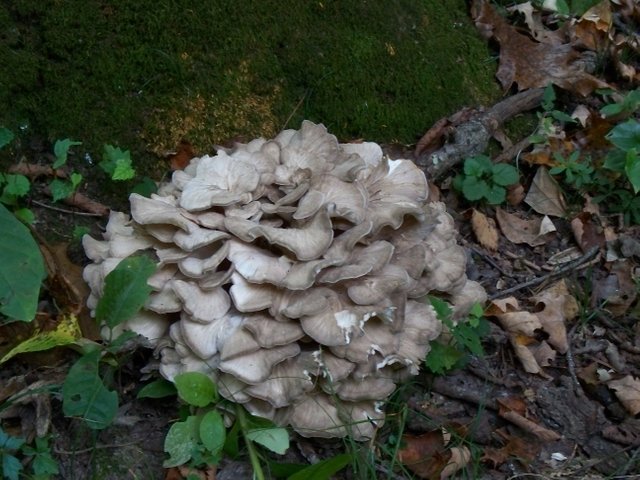
Grifola frondosa - A Mushroom Of Global Fame
You may remember the flamboyant Chicken of the Woods, L.sulphureus and its kin. Well, a little more restrained in its physical appearance, but perhaps even more famous around the world, is G.frondosa.
In the west, it is known as the "Hen of the Woods", perhaps a reference to the relative muteness of its plumage compared to the "rooster" that is L.sulphureus. Or, if you believe Tom Volk, the name might come from a fleeting resemblance to a roosting hen... one which I do not see.
You may also know this mushroom by its Japanese name, Maitake - which may or may not mean "Dancing Mushroom", after the joyful dance mushroom hunters break out in when one of these is found.
Who knows where or why naming conventions take hold. For our purposes this is G.frondosa, and it really is a joy to find.
That photo up top is from wikicommons, but take a look at a slightly older specimen I found in central park.
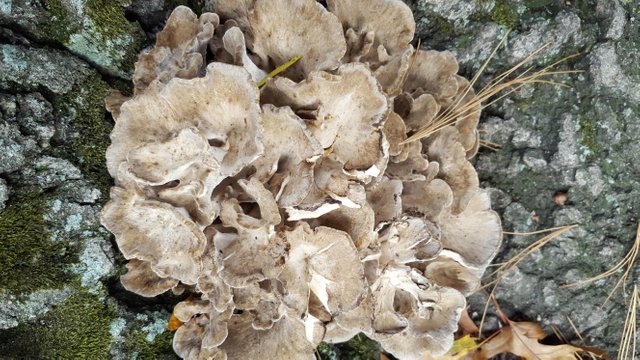
This guy was a little less robust, and beginning to dry out.
G.frondosa is a fairly straightforward mushroom to identify, with few real lookalikes in North America and a series of easy to recognize macroscopic characteristics.
As we've discussed a few times before, sometimes certain mushrooms have an affinity for a specific species trees, either growing parasitically on them or mycorrhizally in a mutually supportive nutritional arrangement.
In the case of G.frondosa, the affinity with Oak trees can be both an important species identifier, as well as a helpful homing beacon if you go out to hunt G.frondosa.
This colony has set up shop on the butt/roots of an oak tree in central park.
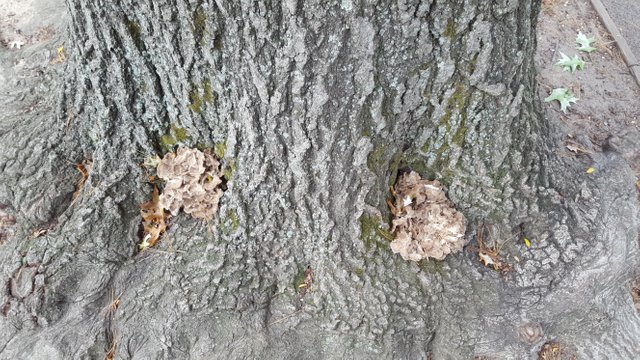
These two florets or rosettes of G.frondosa are several days old
Nonetheless, they continue to be fairly robust, despite a relative paucity of rain.
As I mentioned last week in the first tree health special, G.frondosa is technically a parasitic mushroom. However it is only "weakly" parasitic, to quote multiple sources.
Being a weak parasite doesn't make you a helpful parasite, and G.frondosa is still, technically, a net harm to its host tree. But, as compared to some aggressive tree killers in the Ganoderma or Laetiporus genuses, G.frondosa can live for many years on an infected tree without causing any deleterious signs or symptoms.
Lets get a closer look
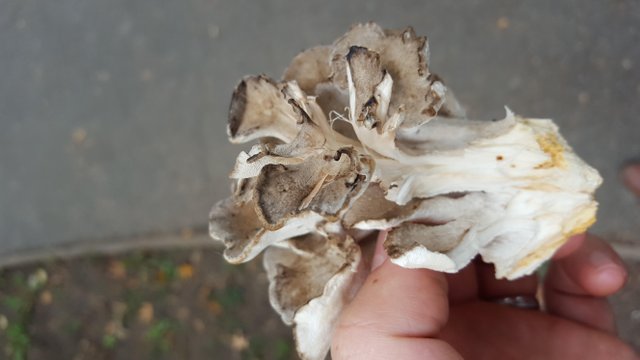
Here I've pulled off a frond
G.frondosa grows out from the roots or dead wood, with a tough stem that soon differentiates into a sometimes very wide and tightly packed collection of caps, layered in a floret shape.
The whole structure can get quite large, nearly half a meter in diameter sometimes, as well as quite heavy. If you take a look at the individual caps, you can see they've taken on a darkish tan color with some darkening around the edges. The young mushroom tends to be on the gray side of things, although as always color is variable.
Lets flip that over
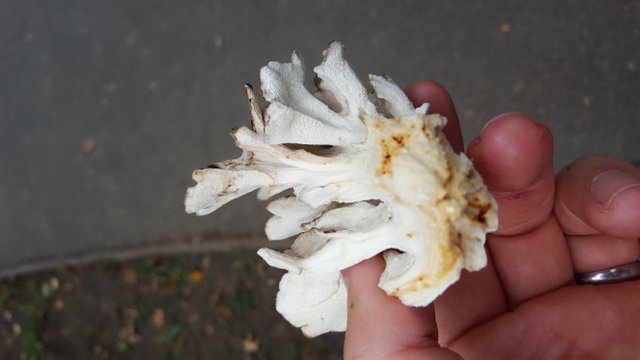
All white, small pored surface, with the pore travelling down the length of the cap toward the stem
When the mushroom is younger, the pore surface is often grayer and then whitens with age. It does not bruise when damaged, although you can see the slight yellowing near the bottom.
Computer, enhance.
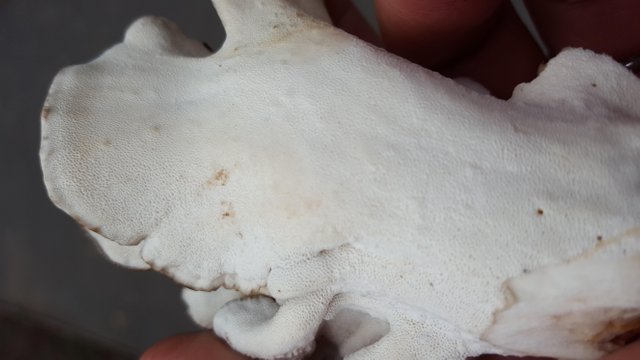
Take a look at that smooth, tightly packed pore
surface.
G.frondosa has a white spore print and, although a spore print is certainly retrievable from a young specimen, this guy was pretty old and pretty dry. I brought home a couple of the moistest caps I could find and left them covered for a couple of days. Nonetheless, I hardly got any spores from them except for a tiny patch of white near one of the edges.
The mushrooms had a very slight mushroomy odor, but only when I tore a cap in half and squished it a bunch, which again is a result of dehydration.
Unfortunately this mushroom was caught before my KOH arrived - still waiting on the application bottles BTW - but it wouldn't have mattered as KOH is non reactive on G.frondosa.
Careful examination easily distinguishes G.frondosa from its only realistic lookalike.
https://upload.wikimedia.org/wikipedia/commons/0/02/Black-staining_Polypore_-Flickr-_treegrow.jpg
Meripilus sumstinei, or the black staining polypore.
This mushroom grows in similar ecologies as G.frondosa, with similar cap colors. However, M.sumstinei begins life with white gills rather than grayish, and - as its nickname implies - its pore surface bruises and stains black, unlike G.frondosa which does not change color.
G.frondosa is one of the most recognizable mushrooms in the world, and it is probably growing on an oak tree near you as you read this. Get out there and take a look.
MACROSCOPIC CHARACTERISTICS
Cap = The floret or rosette shape is made up of many small individual caps, colored from gray to light brownish/tan, getting darker and toward the brown side as it ages. Each individual cap can range from 3-13 centimeters across according to kuo, although even smaller is possible and 13 is pretty big. The whole floret can be pretty big, and weigh quite a lot - up to half a meter, based on anecdotes I've heard.
Spore surface = Small pores, smooth to the touch, starting grayish and aging into white - does not bruise when damaged. May stain yellow with age.
Flesh = white, and the color does not change when cut or damaged. More tender when young, tougher and firm when older or dessicated.
Stem ("stipe") = Present, tough, not always central, white with yellow staining. Causes a white butt rot on the tree.
Spore Print = White
Ecology ("How it grows.") = "Lightly" parasitic, usually on oaks in the northeastern Americas. Also saprobic on dead hardwood, also usually oak. Sometimes on oak roots, in which case it could look terrestrial.
Distribution = Definitely abundant in the eastern US - present in other parts of the world as well, including, obvoously, Japan. But i would do local research depending on where you are to confirm.
Hide quoted text
- EDITOR'S NOTE: It's worth mentioning here that my last post received a little push back for neglecting to place fungal tree infections in a broader natural context and, as a result, sort of demonizing these parasitic species. Briefly, I'll say now that all of the species I talked about last time, as well as G.frondosa, play important ecological roles in their natural habitats, including the culling and decomposition of old growth trees. My post last Thursday was intended to highlight the outsized effects of these parasitic mushrooms on human designed parks and public spaces, which is perceived as more inherently destructive because of the already limited number of trees involved and the status of those trees as relics of urban delevopment. However, in order to get a better picture of mushrooms and tree health, I will be doing a second dpost expounding upon both the role of parasitic mushrooms in natural growth forests and the amazing interplay between certain trees and their mycorrhizal companions.
THIS POST IS NOT INTENDED FOR FORAGING PURPOSES AND TO USE IT FOR THOSE PURPOSES WOULD BE DANGEROUS. DO NOT HUNT WILD MUSHROOMS WITHOUT RELYING ON A COMBINATION OF PROFESSIONAL FIELD GUIDES, IN PERSON PROFESSIONAL GUIDANCE, OR IN PERSON GUIDANCE BY SOMEONE TRUSTWORTHY WHO HAS COPIOUS LOCAL, SPECIALIZED MUSHROOM HUNTING EXPERIENCE. FAILURE TO DO SO CAN RESULT IN GRIEVOUS PERSONAL HARM OR DEATH.
Photos Are My Own Except:
[1]This image was created by user Patrick Harvey pg_harvey at Mushroom Observer, CC-SA-3.0, via Wikimedia commons
[8]Katja Schulz from Washington, D. C., USA, CC-SA-2.0, via Wikimedia commons
Information Sources:
[1]Kuo on G.frondosa
[2]Tom Volk on G.frondosa
[3]Messiah College on G.frondosa
[4]Wikipedia On G.frondosa
[5]Kuo on M.sustinei
The mushrooms are really full of nutrients but their identification is very crucial because most of them are poisonous. Nice post @dber
Statistically it may not be that most are poisonous, but many are, and some in a very deadly way. Which is why I don't suggest foraging for mushrooms for eating purposes unless you are a professional or with a professional.
The consequences of making a wrong guess or a misidentification about whether a mushroom is edible can be severe, sometimes requiring a liver transplant or even resulting in death. There were 6,429 cases of people eating poisonous mushrooms and two deaths from toxic mushrooms in 2011, the last year for which data is available, according to the American Association of Poison Control Centers in Alexandria, Virginia.
Although I can't speak to those specific statistics, as you can see from my copious disclaimers and leaving out entirely any information about edibility, I agree with the sentiments of this comment completely. Don't eat wild mushrooms unless you are 100% sure of the ID, and the safety of the land /growth medium, and are a professional or supported by professionals. Even then, professionals still make mistakes. Mushroom hunting for food is an inherently risky activity.
So only about 1 / 750,000th dangerous as getting in a car. Seems pretty legit to me. I love foraging...besides you know what they say....
I'd rather take my chances living out under the great sky and proud forests, then kill myself slowly on slave food that is very "safe".
Pretty cool information about mushroom .
Wow! I deserve that note.
I can be a real pain in the ass sometimes. I wasn't trying to criticize your article. That was not my intention, my apologies if it came across like that.
With respect to G. frondosa, I've seen some people picking Bondarzewia berkeleyi thinking it was the Hen of the Woods, although they don't look much alike to me.
I've also heard of a rare lookalike called Polyporus umbellatus, but I've never found it in southern Ontario.
Also, I’ve heard of people mistaking g.frondosa for Berkeley’s polypore, and vice versa. However I just didn’t really see enough of a resemblance to include it. That’s a bit shortsighted of me though, as I have seen some really facially ridiculous misidentifications before... :/
You're not a pain in the ass at all! Haphazard also made totally legitimate points that the article left out - and its all too easy to demonize fungi in general without a self professed mushroom lover joining in the action.
I think, whether intended as criticism or not, it is a criticism that can totally, and rightfully should, be applied to the last post and warrants another post for clarity on the flip side of the coin.
Your input, and the input of several other key readers, is really important to me and much appreciated!
I can't wait to see your take on the benefits of mushroom in the environment.
I never tasted any species of mushroom. Though my friends have it now and then in their meals yet I could not eat it. Fear of getting die!
Perhaps there is a store or market where you can buy some to try.
Upvoted. I'm going to resteem this now :)
i like the mushrooms which are tree shaped ;) i used to draw and paint them in my childhood... with so many colors ...
Pretty much countless options for drawing and coloring - someone should make an adult mushroom themed coloring
Pretty cool info on the srooms, i like the guide and what not, this could be handy but with being very careful. I do like mushrooms. The good ones. Stay a Funguy ✌😉 be well @dber
:) will do @krazypoet. And i'll refer to my other comments and disclaimers re
nice typo in title :P
Hah - oops - ftfy
@abdullatifphadia The outcomes of making a wrong figure or a misidentification about whether a mushroom is eatable can be extreme, now and then requiring a liver transplant or notwithstanding bringing about death. There were 6,429 instances of individuals eating noxious mushrooms and two passings from dangerous mushrooms in 2011, the most recent year for which information is accessible, as per the American Association of Poison Control Centers in Alexandria